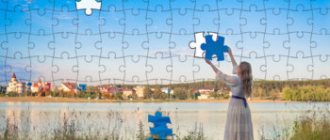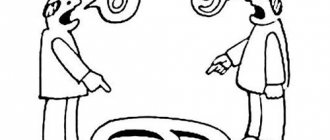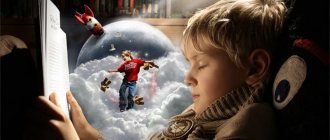Imagination is the process of creating new images of the future, based on previous experiences and creative thinking. It plays an important role in creating images that were not accepted by a person in reality, influences the strength of emotions and feelings, and is an important factor in the development of human personality.
“ “Imagination is a necessary and integral moment of thinking, since thinking always includes the processes of forecasting and anticipation.” L.S. Vygotsky
It tends to develop under the influence of broadening one’s horizons, accumulating experience, images and information. Attention has been paid to the development of imagination since childhood; many children's games and exercises in preschool and secondary educational institutions are aimed at it.
Another property of imagination is that it is not constant, periods of decline alternate with rises, so-called inspiration, but it has been scientifically proven that inspiration and fresh ideas often come to us precisely in the process of work, after a certain amount of effort.
Classifications
By degree of activity:
- Active (stimulates the implementation of created images, activates creative activity, sometimes requires great effort if the creation of images is necessary for work, for example, like writers, screenwriters, decorators).
- Passive (does not encourage a person to take active action, but only generates images in his mind with which he is satisfied without realizing them, or they are, in principle, not realizable).
By type:
- Productive (creates new elements, so-called fantasy products, something that did not previously exist).
- Reproductive (imagination based on existing phenomena and objects).
- Dreams (the process of imagination aimed at the real future).
- Hallucinations (images created by altered consciousness).
- Dreams.
In connection with past experience:
- Recreating (imagination that is based on experience).
- Creative (creating new images with minimal reliance on experience)
Main types
There are many examples in history when fantasies were later reflected in reality. Science fiction writers and inventors actively studied the world around us and were able to predict the development of humanity.
For example, computers, video calls, and space flights are found in the works of writers of the 20th century. In the 21st century, all this has become everyday things.
Children's imagination manifests itself most clearly during games.
Therefore, fantasy has its own functions; it cannot be considered a useless process. Psychologists don't know exactly why some people exhibit this ability more than others. There are several types of imagination.
Active
It was with his help that the entire culture was created. Active fantasy serves as motivation for a person, since he clearly imagines the result of his productive activity. With the help of certain actions, the image of the future is brought closer.
For example, a sculpture conceived a statue. He takes an ordinary piece of stone and begins to chip away at it little by little. The result is a specific figure.
In this type of imagination, a person is guided by his idea of an object that does not exist in nature. Therefore, such fantasies made it possible to create all objects of art.
Passive
This species is characterized by dreams and fantasies. A person only invents different images, but is in no hurry to translate them into reality. This process is not dangerous, but some people devote all their time to it and give up on real work.
Dreams themselves help to distract from problems
A person himself evokes images, indulges in daydreams and imagines what and how he will change. A simple example of passive imagination is Oblomov from Goncharov’s novel. He lay on the sofa, dreaming about how he would get married and improve the estate. But even for the sake of the woman he loved, he did not dare to change anything, and remained with his dreams.
Alternative
There is another classification of fantasies. She distinguishes between voluntary and involuntary imagination. What characterizes voluntary imagination is its appearance when solving specific problems. For example, when doing math tasks, you need to visualize the solution
This is especially important for doing geometry exercises.
In dreams and random visions, this is where voluntary imagination is usually found. This happens especially often during meditation or other trance practices.
There is another classification that distinguishes reproductive and productive imagination. The first is characterized by the creation of images that are as close as possible to real objects. For the second, the material is processed as much as possible in the author’s thoughts, and then implemented in life. Different classifications allow you to look at the same term differently.
Techniques of creative imagination
- Agglutination (creating a new image from two or more existing ones, for example, the fabulous “Hut on Chicken Legs” appeared as a combination of “hut” and “chicken”).
- Analogy (the image is built on the basis of an existing one, but with exaggerated or understated characteristics, for example, epic heroes who had fabulous strength and could fight the enemy one on one).
- Typification (a single image of a typical, existing image, for example, a painting by landscape artists).
- Association (creation of a holistic image based on small units of already existing images).
- Personification (creating an animate image based on inanimate elements. Most often used in myths and fairy tales).
Creative imagination can be scientific, artistic, technological - in a word, it can be used in almost all spheres of human life. It is important to distinguish between creative imagination and dreams, since it belongs to the active type and is further aimed at realizing the created images, while dreams are a passive type, they may not motivate a person to action.
How images arise
There are various ways to create them.
Emphasis is the highlighting of any parts, features or properties. The following techniques are used here:
Typification is a generalization of an image and its emotional saturation. Many literary heroes are shining examples of typification. For example, Gogol’s landowners from “Dead Souls”: Manilov is a barren dreamer, Korobochka is a greedy hoarder, Nozdryov is a dashing reveler.
Combination is the creation of a new one by combining parts of an existing one.
Exaggeration is the deliberate strengthening of any characteristic feature or phenomenon. For example, the expression: “This morning I drank ten liters of coffee” would be an exaggeration.
Exaggeration and understatement. Gulliver can be considered a striking example of both.
Combination is a combination of elements that already exist in new combinations.
Methods for developing creative imagination
There are many specific exercises for developing creative imagination, but it is worth noting that the main factor is the accumulation and expansion of experience - scientific, creative, technical. The more information and images there are in a person’s mind, the more actively his imagination will work, relying on them, synthesizing and giving birth to new ones.
Gaining experience can be done in the simplest ways - reading books of different genres (fiction, detective stories, poetry are especially useful), visiting museums, theaters, watching films, traveling, communicating with different people, learning new skills.
In addition to broadening your horizons, it is important to develop your powers of observation - pay attention to small details of the world around you, try to remember them, for example, small details on the facade of a historical building, store signs, advertisements, and the appearance of passers-by. It seems to us that we do not remember these details, but they remain in our subconscious and, if necessary, emerge during the creative process, helping it.
Examples from life.
People often imagine. Waking up early in the morning, a person mentally chooses clothes, combining his things in his head.
After leaving home, we think about the shortest route to work or school, taking into account weather changes or other conditions.
After a hard day's work, we figure out what to cook from the available ingredients.
But it’s not only in everyday life that we use our imagination. For example, during a renovation, we mentally arrange the furniture around the room and imagine what the room will look like after the renovation.
When a person is alone with his thoughts, a great imagination is activated. Being alone, you can penetrate to a deep level of imagination and find answers to all the answers that interest you.
Exercises to develop imagination
- Come up with a title and description for the picture. For this exercise, it is advisable to go to a museum of modern fine art or find a gallery of surrealist artists on the Internet. The main condition is that the picture should not be realistic and obvious in content. Study it with your eyes and write it down, or recite the options for names and plot. Paintings by Salvador Dali or Pablo Picasso are good for this workout.
- Solving visual riddles or doodles. These are laconic images that can be interpreted in different ways, there is no correct answer to the content, all the images that your image creates will be correct and the more of them, the better.
- Coming up with a biography for passers-by on the street or passengers in transport. When describing a person’s life, try to think through as many details as possible: who his family is, what institute he graduated from, where he works, and so on.
- Burime or collective poetry writing. This is not only a fun, popular game, but also an effective exercise for developing creativity. Principle of the game: the first participant writes several rhyming lines on a piece of paper, wraps the sheet so that only the last line is visible and passes it on to the next participant, who also comes up with a verse based on this line, wraps the sheet and passes it on. At the end, the sheet is unfolded and the “poem” composed by common effort is read out by one of the players.
To make the result interesting, it is better to avoid banal rhymes and not use cognate words and pronouns. The more unexpected the rhyme, the better. You can play in burim by discussing the rules in advance (for example, the size of the verse and the content), or you can simply come up with funny rhymes without a specific focus.
- Crocodile. This well-known game for noisy groups is an ideal trainer for creative imagination. The rules of the exercise are simple and familiar to everyone - one participant tells the other in the ear a word (this can be a noun, a stable combination, a verb or an adjective, you can establish rules at the beginning that, for example, only nouns or only verbs are used) and he must only Using gestures, explain this word to other participants.
- Activity. It is also not only an exercise, but also a popular game and has many varieties. The classic version is a set of cards of varying difficulty in which players need to draw, show or verbally describe the word written on them.
Even more exercises to develop creative imagination and fantasy can be found on the website:.
Functions
- Prompting activity with the help of a bright, attractive image of its result, means and methods of implementation, generalized ideas and specific plans.
- Regulation of behavior in an uncertain, problematic situation with the help of images of alternative actions and their consequences.
- Emotional self-regulation, autopsychotherapy, illusory satisfaction of needs. This function comes with the risk of escaping reality. Replacing reality with gaming images is one of the consequences of gambling addiction.
- Organization of cognition - reconstruction of an object according to description, completion of missing elements, modeling.
Functions and role
Tasks:
- Conveying reality through fantasy. Representation helps to reproduce seen phenomena and objects, remember them, and use them to transform reality.
- Regulation of behavior. When faced with a problematic situation, an individual can predict a program of action. Having selected a scenario, it adjusts the behavior according to the desired outcome.
- Managing emotions. In an excited emotional state, a person can use his imagination to relieve tension by imagining calming images.
The inability to plan causes frustration: the individual cannot start work, postponing until later. People with undeveloped imagination cannot concentrate even on urgent matters. They themselves don’t understand what’s stopping them.











